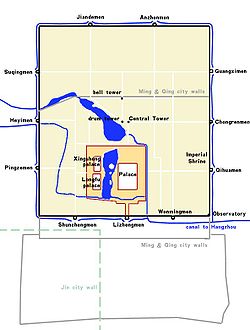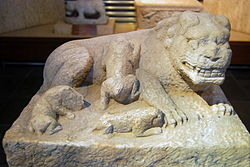Khanbaliq
| Khanbaliq (Dadu of Yuan) | |
|---|---|
| Native name 汗八里 Wade-Giles: Han-pa-li | |
| (元)大都 (Yüan) Ta-tu | |
 | |
| Type | Former capital city |
| Location | Beijing, China |
| Coordinates | 39°56′0″N 116°24′0″E / 39.93333°N 116.40000°E |
| Founded | 1264 |
| Founder | Kublai Khan |
| Khanbaliq | |||||
|---|---|---|---|---|---|
Mongolian Cyrillic Хаан балгас, Ханбалиг | | ||||
| Mongolian script | ᠻᠠᠨᠪᠠᠯᠢᠺ | ||||
| |||||
| Dadu | |
|---|---|
| Chinese name | |
Hanyu Pinyin | (Yuán) Dàdū |
| Wade–Giles | (Yüan) Ta-tu |
| Transcriptions | |
|---|---|
| SASM/GNC | Daidu |
| Beiping | |
|---|---|
Hanyu Pinyin | Běipíng |
| Wade–Giles | Pei-p'ing |
Khanbaliq or Dadu of Yuan (Chinese: 元大都Mongolian: ᠻᠠᠨᠪᠠᠯᠢᠺ) was the winter capital[1] of the Yuan dynasty of China in what is now Beijing, the capital of China today. It was located at the center of modern Beijing. The Secretariat directly administered the Central Region (腹裏) of the Yuan dynasty (comprising present-day Beijing, Hebei, Shandong, Shanxi, and parts of Henan and Inner Mongolia) and dictated policies for the other provinces. As emperors of the Yuan dynasty, Kublai Khan and his successors also claimed supremacy over the entire Mongol Empire following the death of Möngke (Kublai's brother and predecessor) in 1259. Over time the unified empire gradually fragmented into a number of khanates.
Khanbaliq is the direct predecessor to modern Beijing. Several stations of
Name
The name Khanbaliq comes from the
The name Dadu is the pinyin transcription of the Chinese name 大都, meaning "Grand Capital". The Mongols also called the city Daidu,[4] which was a transliteration directly from the Chinese.[5] In modern Chinese, it is referred to as Yuan Dadu to distinguish it from other cities which have similar names.
History
In 1264,
The construction of the walls of the city began in the same year, while the main imperial palace (大内) was built from 1274 onwards. The design of Khanbaliq followed several rules laid down in the Confucian classic The Rites of Zhou, including "9 vertical and horizontal axes", "palaces in front, markets in back", "ancestral worship to the left, divine worship to the right".[clarification needed] It was broad in scale, strict in planning and execution, and complete in equipment.[11]
A year after the 1271 establishment of the Yuan dynasty, Kublai Khan proclaimed the city his capital under the name Dadu[12] as it is interpreted capital city in Hanzi and named Khanbaliq as referred in the state diplomatic letters in Mongolian. The construction was not fully completed until 1293. His previous seat at Shangdu (Xanadu) became the summer capital.
As part of the
Confucians and Taoists were extremely well-regarded by most Mongol nobles, and "some of the Mongols' most esteemed advisors were Taoists and Confucians."[15]
It even was the seat of a
The Hongwu Emperor of the Ming dynasty sent an army to Dadu in 1368. The last Yuan emperor fled north to Shangdu while the Ming razed the palaces of their capital to the ground.[16] The former capital was renamed Beiping[17] (北平 "Pacified North") and Shuntian Prefecture was established in the area around the city.
The Hongwu Emperor was succeeded by his young grandson the
Legacy
Ruins of the Yuan-era walls of Khanbaliq are still extant and are known as the Tucheng (

Despite the capture and renaming of the city by the
Khanbaliq remained the standard name for
When European travelers reached China by sea via
See also

References
- ^ Masuya Tomoko, "Seasonal capitals with permanent buildings in the Mongol empire", in Durand-Guédy, David (ed.), Turko-Mongol Rulers, Cities and City Life, Leiden, Brill, p. 236.
- ^ Brill, E.J. Encyclopedia of Islam, Vol. 4, pp. 898 ff. "Khānbāliķ". Accessed 17 November 2013.
- ^ Brill, Vol. 2, p. 620. "Bāliķ". Accessed 17 November 2013.
- ^ Rossabi, Morris, Khubilai Khan: His Life and Times, p 131
- ^ Herbert Franke, John K. Fairbank (1994). Alien Regimes and Border States. Vol. 6. Cambridge: Cambridge University Press. p. 454.
- ^ Vogel, Hans. Marco Polo Was in China: New Evidence from Currencies, Salts, and Revenues, p. 121. Brill, 2012. Accessed 18 November 2013.
- ^ China Archaeology & Art Digest, Vol. 4, No. 2-3. Art Text (HK) Ltd. 2001. p. 35.
- ^ Steinhardt, Nancy Riva Shatzman (1981). Imperial Architecture under Mongolian Patronage: Khubilai's Imperial City of Daidu. Harvard University. p. 222.
The planning of the Imperial City, along with many other imperial projects of the 1260s, was supervised by Khubilai's close minister Liu Bingzhong. That the Imperial City was Chinese in style was certainly Liu's preference...
- ISBN 0-415-34850-1.
Liu Bingzhong was also charged with overseeing the construction of the Great Khan's other new capital, the city of Dadu.
- ^ The People's Daily Online. "The Hui Ethnic Minority".
- ^ 《明史紀事本末》. "綱鑑易知錄", Roll 8. (in Chinese)
- ^ The New Encyclopædia Britannica (Encyclopædia Britannica, Chicago University of, William Benton, Encyclopædia Britannica), p 2
- OCLC 123079516.
- OCLC 123079516.
- ^ OCLC 123079516.
- ISBN 0-521-66991-X.
- ^ Naquin, Susan. Peking: Temples and City Life, 1400–1900, p. xxxiii.
- ^ "Beijing This Month - Walk the Ancient Dadu City Wall Archived 2008-10-20 at the Wayback Machine".
- ^ a b Amitai-Preiss, Reuven & al. The Mongol Empire & Its Legacy, p. 277.
- ISBN 978-0-316-85988-2.
- ISBN 0-933070-37-3.
- ^ Louis J. Gallagher's translation.
- ^ Trigault, Nicolas. De Christiana expeditione apud Sinas (in Latin). Translated by Louis J. Gallagher as China in the Sixteenth Century: The Journals of Mathew Ricci: 1583–1610, Book IV, Chap. 3 "Failure at Pekin", pp. 312 ff. Random House (New York), 1953.
External links
- Yule, Henry (1878). . Encyclopædia Britannica. Vol. IV (9th ed.). pp. 722–723.

